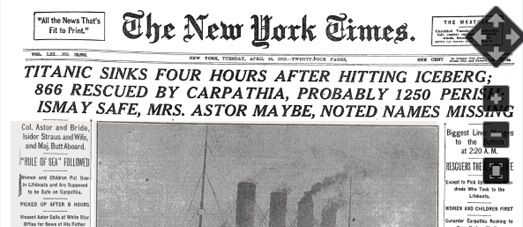
My favorite map of this week wasn't even a map. However it does use a map library, it does use map tiles and it does have pan & zoom controls.
The New York Time has used the Leaflet.js mapping library to provide an interactive interface that allows you to browse through 129 years of New York Times back editions. You can use the application to read through a number of historical events as reported in the New York Times at the time, including the shooting of President Lincoln, the sinking of the Titanic and the landing of the first men on the moon.
By using the popular Leaflet.js mapping platform, the New York Times provides users with the familiar navigation controls that they understand from using online interactive maps. The TimesMachine includes panning, zoom controls and the click & drag method that web users are familiar with from using mapping platforms, such as Google Maps.

The 34th London Marathon took place today. If you missed it don't worry as you can view the whole route in Google Maps Street View. Explore Marathon has released a Street View animation of the whole London Marathon course.
The application allows you to simply press play and sit back and watch a first person view of the whole of the London Marathon course. During your tour of the route you can press pause at any time and use Google Maps Street View to take in the full 360 degree panoramic view of a location.
The application is a great way to explore the London Marathon route and at the same time take in some of the sights of London, such as Tower Bridge, the London Eye and the Houses of Parliament.
If viewing the whole of the marathon route is simply too much at this stage of your couch running training schedule then you can use the slider control to skip through the animation and immediately transport yourself to different locations along the course.

The Milwaukee Building Age Map is a MapBox powered map that visualizes the age of buildings in this Wisconsin city.
We have seen a lot of these building age maps in the last year (see the list below). The Milwaukee Building Age map follows a familiar format by shading buildings on the map by their year of construction.
However the Milwaukee map also includes a useful graph that visualizes the number of buildings built by year. This highlights a construction boom in the 1950's. In conjunction with the map we can clearly see the growth of Milwaukee in the 50's in the northeast and in the south of the city.

No comments:
Post a Comment